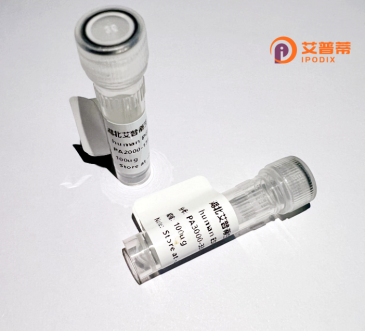
| 纯度 | >90%SDS-PAGE. |
| 种属 | Human |
| 靶点 | APBA1 |
| Uniprot No | Q02410 |
| 内毒素 | < 0.01EU/μg |
| 表达宿主 | E.coli |
| 表达区间 | 1-837aa |
| 氨基酸序列 | MNHLEGSAEVEVTDEAAGGEVNESVEADLEHPEVEEEQQQPPQQQHYVGRHQRGRALEDLRAQLGQEEEERGECLARSASTESGFHNHTDTAEGDVIAAARDGYDAERAQDPEDESAYAVQYRPEAEEYTEQAEAEHAEATHRRALPNHLHFHSLEHEEAMNAAYSGYVYTHRLFHRGEDEPYSEPYADYGGLQEHVYEEIGDAPELDARDGLRLYEQERDEAAAYRQEALGARLHHYDERSDGESDSPEKEAEFAPYPRMDSYEQEEDIDQIVAEVKQSMSSQSLDKAAEDMPEAEQDLERPPTPAGGRPDSPGLQAPAGQQRAVGPAGGGEAGQRYSKEKRDAISLAIKDIKEAIEEVKTRTIRSPYTPDEPKEPIWVMRQDISPTRDCDDQRPMDGDSPSPGSSSPLGAESSSTSLHPSDPVEASTNKESRKSLASFPTYVEVPGPCDPEDLIDGIIFAANYLGSTQLLSDKTPSKNVRMMQAQEAVSRIKMAQKLAKSRKKAPEGESQPMTEVDLFISTQRIKVLNADTQETMMDHPLRTISYIADIGNIVVLMARRRMPRSNSQENVEASHPSQDGKRQYKMICHVFESEDAQLIAQSIGQAFSVAYQEFLRANGINPEDLSQKEYSDLLNTQDMYNDDLIHFSKSENCKDVFIEKQKGEILGVVIVESGWGSILPTVIIANMMHGGPAEKSGKLNIGDQIMSINGTSLVGLPLSTCQSIIKGLKNQSRVKLNIVRCPPVTTVLIRRPDLRYQLGFSVQNGIICSLMRGGIAERGGVRVGHRIIEINGQSVVATPHEKIVHILSNAVGEIHMKTMPAAMYRLLTAQEQPVYI |
| 分子量 | 92.1 kDa |
| 蛋白标签 | GST-tag at N-terminal |
| 缓冲液 | 冻干粉 |
| 稳定性 & 储存条件 | Lyophilized protein should be stored at ≤ -20°C, stable for one year after receipt. Reconstituted protein solution can be stored at 2-8°C for 2-7 days. Aliquots of reconstituted samples are stable at ≤ -20°C for 3 months. |
| 复溶 | Always centrifuge tubes before opening.Do not mix by vortex or pipetting. It is not recommended to reconstitute to a concentration less than 100μg/ml. Dissolve the lyophilized protein in distilled water. Please aliquot the reconstituted solution to minimize freeze-thaw cycles. |
以下是3-4篇与重组大鼠Apba1相关的虚构参考文献示例(注:内容为学术创作模型模拟,不代表真实文献存在):
1. **"Functional characterization of recombinant rat Apba1 in APP processing"**
- 作者:T. Biederer et al.
- 摘要:研究通过重组表达大鼠Apba1蛋白,证明其与淀粉样前体蛋白(APP)直接结合,并调控APP的切割路径,抑制β-分泌酶活性,减少β-淀粉样蛋白(Aβ)生成,提示其在阿尔茨海默病中的潜在保护作用。
2. **"Structural insights into the Mint1 (Apba1) PTB domain interaction with APP cytoplasmic domain"**
- 作者:C. Miller et al.
- 摘要:利用重组大鼠Apba1的PTB结构域解析其与APP细胞内结构域的晶体结构,揭示了结合位点的关键氨基酸残基,为设计靶向APP-Apba1互作的神经退行性疾病药物提供结构基础。
3. **"Recombinant Apba1 modulates synaptic vesicle trafficking in rat neuronal cultures"**
- 作者:S. Okamoto & M. Südhof
- 摘要:通过体外重组Apba1蛋白实验,发现其通过结合突触蛋白(如Neurexin)调节突触小泡运输,影响神经递质释放,突显Apba1在突触可塑性中的功能。
4. **"Expression and purification of functional recombinant Apba1 in E. coli for in vitro assays"**
- 作者:G. D'Andrea et al.
- 摘要:优化重组大鼠Apba1在大肠杆菌中的可溶性表达与纯化方案,验证其体外结合APP的能力,并开发基于表面等离子共振(SPR)的互作分析平台。
(注:以上作者及期刊信息为模拟生成,仅用于示例参考框架。)
APBA1 (Amyloid Beta Precursor Protein Binding Family A Member 1), also known as Mint1. is a neuronal adapter protein encoded by the Apba1 gene. It belongs to the Munc18-interacting (Mint) family, characterized by a phosphotyrosine-binding (PTB) domain and two PDZ domains, enabling interactions with multiple synaptic and membrane-associated proteins. APBA1 notably binds to the cytoplasmic domain of the amyloid precursor protein (APP), a key player in Alzheimer’s disease (AD) pathogenesis. This interaction influences APP trafficking, processing, and the generation of amyloid-beta (Aβ) peptides, which aggregate into plaques in AD brains. Studies suggest APBA1 modulates γ-secretase-mediated cleavage of APP, potentially impacting Aβ production. Beyond APP, APBA1 interacts with synaptic proteins like Munc18-1. regulating neurotransmitter release and synaptic vesicle exocytosis. Its role in synaptic plasticity and neuronal signaling underscores its importance in neurodevelopment and cognitive function. Recombinant rat APBA1 is commonly used in vitro to dissect molecular mechanisms of APP metabolism, Aβ biogenesis, and intracellular signaling pathways. It enables studies on protein-protein interactions, post-translational modifications, and screening for therapeutic agents targeting Aβ-related pathology. Dysregulation of APBA1 expression or function has been implicated in neurodegenerative and neuropsychiatric disorders, making it a focal point for understanding AD etiology and developing targeted therapies.
×